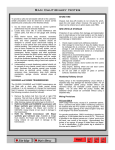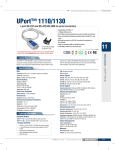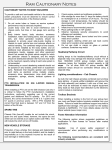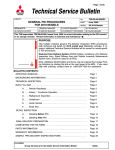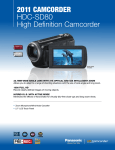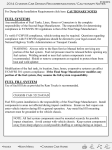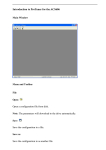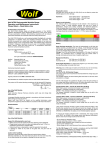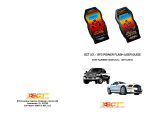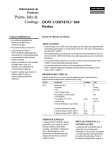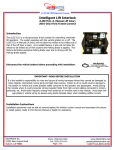Download PRELIMINARY Ram Cautionary Notes
Transcript
PRELIMINARY Ram Cautionary Notes CAUTIONARY NOTES TO BODY BUILDERS SPARE TIRE To provide a safe and serviceable vehicle to the customer, certain precautions must be observed to ensure correct assembly and construction of the finished vehicle. Chassis Cab (box-off) models do not include the winch, spare tire and spare wheel, however, the spare tire and wheel can be ordered as an option (sales code TBE). 1. Do not revise tubes or hoses as service systems’ performance may be seriously impaired. 2. Locate body cross sills to avoid interference with chassis parts, fuel lines or fuel gauge tank sending unit. 3. Body interior layout, body structure, accessory installation, water and holding tanks, fuel and propane tank, and motor generator locations should be designed to provide equal side-to-side loading on chassis to avoid vehicle lean and adverse effects on vehicle handling. The combined weight of the chassis, plus all items installed by the body builder, and an additional load allowance for reasonably anticipated passengers, liquids, luggage, and other equipment should not exceed the gross vehicle weight for which the particular chassis is designed, and the weight should be distributed between the front and rear axles so the maximum capacity rating of each axle system is not exceeded. 4. Undercoating or sound deadening material should not be sprayed on any chassis, power train or suspension parts. Hardware that requires special care includes such items as electrical wiring, radiator, engine, accessory drive, transmission, prop shaft, steering mechanism, springs, shocks, exhaust systems or linkages. NEW VEHICLE STORAGE G56-6 SPEED MANUAL TRANSMISSIONS The G56 transmission (5.7L gas & 5.9L/6.7L diesel) are fitted with drain plug and fill plugs. Under normal driving conditions, it is not necessary to change the transmission fluid. Under extreme usage (as defined in the owner’s manual maintenance schedule) the fluid is changeable at 60,000 mile intervals. If, however, it is necessary to change or remove fluid, the following procedure should be followed: 1. Remove the drain plug. 2. After draining, replace drain plug and torque to 57 Nm (42lb.ft.) 3. The Fluid fill hole is on the right side of the transmission. Fill until fluid begins to run out. The 5.7L G-56 takes 5.1L (5.4 quarts). The 5.9L diesel manual transmission requires 5.9L (6.2 quarts) of fluid. 4. Refill the G56 transmission with Mopar ATF+4. Available at Dodge truck dealers, the Mopar part number is 05013457AA. Using mineral oil can result in damage to the transmission. Replace fill plug and torque to 57Nm (42lb.ft.) Site Map Main Menu Protection of new vehicles from damage and deterioration prior to retail delivery is the body builder’s and his dealer’s responsibility as is any expense incurred as the result of such damage or deterioration. 1. Check engine coolant and antifreeze protection 2. After storage for more than 21 days the battery should be recharged for at a minimum of 24 hours. For long storage in cold temperatures, the battery should be disconnected, removed and stored at a temperature above freezing. 3. Inflate tires to recommended pressure 4. Place parking brake in “off” position 5. Observe necessary security precautions to avoid pilferage and vandalism 6. Keep windows closed, doors locked and trim covers intact and in position 7. Keep engine, steering wheel and cab back covers intact and in position when applicable 8. Do not use chalk or crayon on glass or painted surfaces. Scratches may result Headlamp/Taillamp Circuit Adding lamps to the headlamp/taillamp circuit without a separate relay may damage the electrical system. For all Ram 1500/2500 LD/HD pickup models without cab clearance lamps, the “available” current capacity is 3.5 amps. For all other RAM HD pickup models, NO additional lamps should be connected without using a separate relay. Wiring Provisions PTO and ODB II 2006 Dodge Ram trucks, except 3.7L powertrain options, have a provision that allows ODB II monitoring systems to be disabled while the PTO system is being operated. This will prevent “false” lighting of the “Check Engine” lamp due to the engine-PTO driven accessories. For gasoline applications, ODB II monitoring is disabled by applying a 12-volt ignition feed to circuit G113. This circuit is provided in the engine harness as a “splice” point at the left hand, rear corner of the engine. Approximately five inches of an orange 18 gauge is folded back and taped. To aid in identification, a white plastic tag is attached to this wire and is labeled “PTO”. PRINT + ALL IN OUT PRELIMINARY Ram Cautionary Notes For diesel applications, the PTO circuit needs to be installed from the power train control module (located on the lower driver side of the engine) pin 38 of the 50 position connector to the PTO device. See your dealership for the proper terminal part number. To disable ODB II monitoring, a ground level signal needs to be applied to this circuit. Diesel Exhaust Brake For Ram truck diesel applications the power train control module provides a control circuit for control of an aftermarket exhaust brake. This control can be implemented by purchasing the appropriate Mopar kit from your dealership. Follow the provided directions carefully. Lighting considerations – Cab Chassis As built, the Cab Chassis provides combined rear turn/stop lamp lighting. A typical upfitter installation will remove the tail lamp assembly and replace it with one of their own. Care must be exercised to match the original equipment lamp loads so that proper fault detection by the electronic control module is maintained. Failure to follow these recommendations could result in damage to the basic vehicle and possible injury to occupants. Holes Holes are not to be drilled in the top or bottom of the frame rails. Holes to mount out-riggers, brackets, and supports must be drilled in the web (vertical sides) of the frame rail with the following restrictions: 1. Hole diameter should not exceed 20 mm (0.75 in.). 2. Material between edge of hole and top or bottom of the frame rail must not be less than 40 mm (1.60 in.). 3. The minimum edge distance between any two (2) holes must be larger than twice the diameter of the larger hole. 4. Any thru-fastener that torques down on both external surfaces of the rail must use an internal spacer to prevent crushing the rail tube. 5. All holes should be drilled in the frame using appropriate drilling practice and safety precautions. 6. Avoid drilling holes near the fuel tank, fuel and brake lines and other lines and wires to avoid damage to them. Welding Prior to any welding, the following must be done: Toolbox Brackets When installing a toolbox to the front of your pickup bed, you must use Mopar toolbox brackets available from your dealer. Failure to install the additional support may lead to significant bed damage. (The part number for the toolbox brackets is 82205240.) For more details please visit the Mopar website (www.mopar.com). Caution: Use of proper safety equipment is recommended when performing any modifications or alterations. 1. Avoid welding near the fuel tank, fuel and brake lines or other components that may be damaged by the heat of welding. If it is necessary to weld near these areas, use wet cloths to cover these components. If it is necessary to remove the fuel tank, lines or other components, do it in accordance with applicable service manual procedure. 2. Components near the welding area which could be damaged by excessive heat must be removed or adequately shielded. 3. Disconnect the battery(ies). 4. Precautionary measures should be used to prevent electrical system components or wiring damage. 5. Frame e-coating must be removed from the welding and surrounding area. The following recommendations are consistent with industry standards: Use proper welding techniques to avoid stress risers that may adversely affect frame performance. DaimlerChrysler Corporation doesn’t recommend any modifications or alterations to the frame assembly. Modifications or alterations (i.e. hole drilling, welding, etc.) to the frame assembly are the responsibility of persons performing these modifications or alterations. Anyone altering the frame must assume complete responsibility for assembly, performance, reliability and compliance of applicable FMVSS requirements. After welding: Dodge Fuel Fill Tube Kit The following procedures and specific precautionary instructions are recommended for proper installation of special bodies and/or equipment on the Ram Frame. A new fuel fill housing will be included in box-off models and has been designed for easy installation (external flange mounted) and to insure proper fuel tube fill angle of Frame Alteration Information The following section shows suggested guidelines on modification of Dodge Ram frames for various after market applications. Site Map Main Menu 1. Carefully inspect electrical components and wiring for shorts or other damage. 2. Apply protective coating to areas where coating was removed. PRINT + ALL IN OUT PRELIMINARY Ram Cautionary Notes 37°. Included in the kit are installation instructions, various fill and vapor hoses that can be cut and assembled per body applications, hose clamps, ground strap, and a hose connector. A DIESEL or GAS fuel label will also be included depending on application. The part numbers for the kits are: Diesel: 52121252AA Gas: 52121251AA Installation Suggestions • • • • Always mount the fuel fill housing as high as possible and route the fuel fill tube on a continuous downward slope (approx. 37°) to insure good fuel fill quality. Mount the fuel fill tube upper with the vent tube at the 9:00, 12:00 or 3:00 position. When routing the vent tube, make sure there are no dips or sags. It should have a downward slope from the “fuel filler tube upper” to the fuel tank vent nipple. Tie strap it to prevent any sags that may accumulate fuel in the hose. Always connect the ground strap from the fuel fill upper to the frame. This is a must! If the ground strap is not attached Electro static build up could occur during refueling. Since the guidelines might not be appropriate for every application of a body installation, following the guidelines listed above does not eliminate the responsibility of the second stage manufacturers to certify to compliance to FMVSS and CMVSS standards. The final stage manufacturer who installs a second unit body on the chassis is responsible for compliance with (1) 2 3 (3)(4) (3) ,219 , and FMVSS/CMVSS 204 , 208 , 212 , 214 (3) Federal Regulations. Questions regarding 301 compliance with FMVSS/CMVSS regulations should be directed to your legal counsel, the National Highway Traffic Safety Administration, or Transport Canada. Body Mount Guidelines for Dodge Ram (2500/3500) The following section shows suggested guidelines for Body Mounts for Dodge Ram 2500/3500 applications. Caution: Use of proper safety equipment is recommended when performing any modification or alterations. These guidelines apply to second stage manufacturers who mount a body to the Ram Pickup Truck. This applies to trucks which have been ordered from the factory with the box deleted or those where the factory installed box is removed after delivery. • • • The mounting location brackets on the chassis that are used for the pickup bed mounting should be utilized for installing the new body. On the short bed there are six mounting location brackets and on the long bed there are eight. Grade 10.9 M12 Fasteners (or equivalent) should be used. Torque to 60 + ft-lbs. With the body in position the gap between the body mounting points and the chassis mounting brackets should be minimized to assure that there is no distortion of the chassis mounting brackets when the body mounting fasteners are torqued to specification. Metal spacers are recommended in cases where the gap exceeds 2 mm. Site Map Main Menu PRINT + ALL IN OUT



